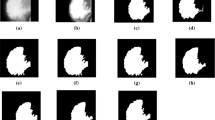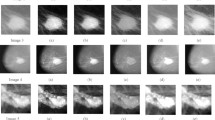Abstract
Purpose
Ultrasound imaging is an effective approach for diagnosing breast cancer, but it is highly operator-dependent. Recent advances in computer-aided diagnosis have suggested that it can assist physicians in diagnosis. Definition of the region of interest before computer analysis is still needed. Since manual outlining of the tumor contour is tedious and time-consuming for a physician, developing an automatic segmentation method is important for clinical application.
Methods
The present paper represents a novel method to segment breast ultrasound images. It utilizes a combination of region-based active contour and neutrosophic theory to overcome the natural properties of ultrasound images including speckle noise and tissue-related textures. First, due to inherent speckle noise and low contrast of these images, we have utilized a non-local means filter and fuzzy logic method for denoising and image enhancement, respectively. This paper presents an improved weighted region-scalable active contour to segment breast ultrasound images using a new feature derived from neutrosophic theory.
Results
This method has been applied to 36 breast ultrasound images. It generates true-positive and false-positive results, and similarity of 95%, 6%, and 90%, respectively.
Conclusion
The purposed method indicates clear advantages over other conventional methods of active contour segmentation, i.e., region-scalable fitting energy and weighted region-scalable fitting energy.


Similar content being viewed by others
References
Cheng HD, Shan J, Ju W, Guo Y, et al. Automated breast cancer detection and classification using ultrasound images: a survey. Pattern Recogn. 2010;43:299–317.
Jesneck JL, Lo JY, Baker JA. Breast mass lesions: computer-aided diagnosis models with mammographic and sonographic descriptors 1. Radiology. 2007;244:390–8.
Shan J, Cheng HD, Wang Y. A novel segmentation method for breast ultrasound images based on neutrosophic l-means clustering. Med Phys. 2012;39:5669–82.
Coupé P, Yger P, Prima S, et al. An optimized blockwise nonlocal means denoising filter for 3-D magnetic resonance images. IEEE Trans Med Imaging. 2008;27:425–41.
Coupé P, Hellier P, Kervrann C, et al. Nonlocal means-based speckle filtering for ultrasound images. IEEE Trans Image Process. 2009;18:2221–9.
Kervrann C, Boulanger J, Coupé P. Bayesian non-local means filter, image redundancy and adaptive dictionaries for noise removal. International conference on scale space and variational methods in computer vision. Berlin, Heidelberg: Springer; 2007. p. 520–32.
Laws KI. Textured image segmentation. Image processing institute, Report 940. University of Southern California, Los Angeles; 1980.
Guo Y, Cheng HD, Huang J, et al. Breast ultrasound image enhancement using fuzzy logic. Ultrasound Med Biol. 2006;32:237–47.
Chan TF, Vese LA. Active contours without edges. IEEE Trans Image Process. 2001;10:266–77.
Vese LA, Chan TF. A multiphase level set framework for image segmentation using the Mumford and Shah model. Int J Comput Vision. 2002;50:271–93.
Li C, Kao CY, Gore JC, et al. Minimization of region-scalable fitting energy for image segmentation. IEEE Trans Image Process. 2008;17:1940–9.
He C, Wang Y, Chen Q. Active contours driven by weighted region-scalable fitting energy based on local entropy. Signal Process. 2012;92:587–600.
Zhang M, Zhang L, Cheng HD. A neutrosophic approach to image segmentation based on watershed method. Signal Processing. 2010;90:1510–7.
Cheng HD, Guo Y. A new neutrosophic approach to image thresholding. N Math Nat Comput. 2008;4:291–308.
Liu L, Zeng L, Shen K, et al. Exploiting local intensity information in Chan-Vese model for noisy image segmentation. Signal Process. 2013;93:2709–21.
Darvish A, Rahnamayan S. Optimal parameter setting of active-contours using differential evolution and expert-segmented sample image. JACIII. 2012;16:677–86.
Heydarian M, Noseworthy MD, Kamath MV, et al. Optimizing the level set algorithm for detecting object edges in MR and CT images. IEEE Trans Nucl Sci. 2009;56:156–66.
Li C, Xu C, Gui C, et al. Level set evolution without re-initialization: a new variational formulation. Proceedings of the 2005 IEEE computer society conference on computer vision and pattern recognition (CVPR’05). Washington: IEEE computer society; 1;2005. p. 430–36. doi:10.1109/CVPR.2005.213.
Author information
Authors and Affiliations
Corresponding author
Ethics declarations
Conflict of interest
The authors declare that there is no conflict of interest.
Ethical statements
All procedures followed were in accordance with the ethical standards of the responsible committee on human experimentation (institutional and national) and with the Helsinki Declaration of 1964 and later versions.
Informed consent
Informed consent was obtained from all patients for being included in the study.
About this article
Cite this article
Lotfollahi, M., Gity, M., Ye, J.Y. et al. Segmentation of breast ultrasound images based on active contours using neutrosophic theory. J Med Ultrasonics 45, 205–212 (2018). https://doi.org/10.1007/s10396-017-0811-8
Received:
Accepted:
Published:
Issue Date:
DOI: https://doi.org/10.1007/s10396-017-0811-8




